|
| |

French painter and sculptor Edgar DEGAS (1834-1917)
is considered to be one of the major representatives of Impressionism,
due to his innovating composition and his perspective
analysis of motion.
He also was one of the most active organizers
of the Impressionist movement, even though his artistic ideas
were distinct from those of his Impressionist friends.
He was born German Hilaire Edgar de Gas in
Paris on july 1834, of a great and aristocratic family of bankers, rich
and refined. His mother was creole, originating in New-Orleans and his
father, who was an art lover, allows his son to arrange a workshop in
his own house.
|
|
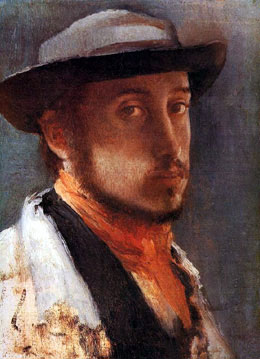
Self-portrait in
a soft hat
1857-58
|

Sterling and Francine Clark
Art Institute
Williamstown, Massachusetts
|
 A TRADITIONAL FORMATION A TRADITIONAL FORMATION
After he studied law for a
short time, he studied painting at the School of Fine Arts
under direction of Lamothe, a disciple of Ingres, painter to
whom he would always dedicate a great admiration. He will acquire a
great art of drawing which will always be a major
characteristic of his art.
In 1859, he leaves for
Italy where he will study during three years Quattrocento
works , in Florence, Naples and Roma, and execute a number of
portraits.
Thus he will thoroughly
study antique art, while planning in his notebook as
soon as 1859, a whole list of contemporary subjects he intends to paint
: musicians, dancers, cafés at night, mourning scenes... all themes
that one can find in his work.
By his social condition,
his culture and his artistical conceptions, Degas has many points in
common with Edouard Manet. Even more than Manet, he
is a figures painter, and would almost never be
interested in landscape.
 AN INNOVATING COMPOSITION AN INNOVATING COMPOSITION
|
"The Bellelli family"
(1858-1860) is one of his first truely personal
paintings, and may be regarded as one of the first
masterpieces of Impressionism.
This painting represents the baron Bellelli, a
revolutionary exiled in Naples in 1848, his wife Laura, daughter of
late Neapolitan banker De Gas and painter's aunt, and their two
daughters out of mourning clothes.
|
| |
|
|
As he will do throughout his work, Degas chooses a new
composition, and already appears as a Master portraitist whose
principal interest is to translate the psychic states of figures.
By its composition - figures with littlely strained
attitudes, the father seen from the back as stuck between pieces of
furniture and relegated to an incomprehensible insignificance -, he
transforms a mourning scene into a banal scene of daily life.
In spite of attitudes that may be interpreted as signs
of family cohesion, looks do not meet and are filled with coldness.
This objectivity and this fugacity of human relationships are a
leitmotiv in Degas's work.
As Manet with his "Olympia", Degas will keep
until his death this painting on which he worked a long time.
|
| |
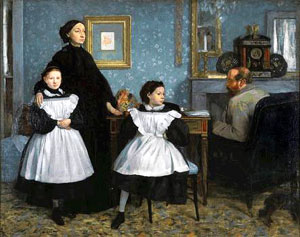 |
|
| |
The Bellelli
family
1858-60
Musée d'Orsay, Paris
|
|
 CONTEMPORARY AND URBAN THEMES CONTEMPORARY AND URBAN THEMES
From 1861, he gave up historical subjects and
started to be interested in horse-races subject, an aristocratic
inhabitude imported from England, that Géricault
(1791-1824) had treated before him. In Longchamp racecourse field,
which had just opened, Degas will attentively study the animation of
racecourses universe - jockeys, preparations and departure of races...
-.
Since 1862 he gets friendly with Manet
(" Portrait of Manet ", 1864), but will not meet Monet
and Renoir before 1865, at the Café Guerbois. From
1865 to 1870, he will successfully send his works each year to the
official Salon. After 1870, he will definitively cease his sendings .
Unlike the other Impressionists, Degas will
always prefer workshop painting and will never share their love for
countryside and open air painting, nor their research about natural
light which was at the center of their preoccupations. Quite to the
contrary, he will study the effects of artificial light (lamps with
gas).
His visual memory enables him to precisely
retranscribe in workshop the subjects which he observed, which he
recreates in a pictorial composition wanted by him.
Degas asserted the artist's right to translate his artistic will, thus
being opposed on that matter to Impressionists who privileged
spontaneity of painting from motif.
Degas will thus say about his art : " No art is
as little spontaneous as mine. What I do is the result of thought and
study of the Old Masters; about inspiration, spontaneity, character, I
know nothing..." or : "I do not want to lose my head in front of
nature".
| |
At that time, while keeping on working on
realistic portraits, such as "Woman with chrysanthemums" - 1865,
Degas sends to the Salon in 1866 a horse-race painting, and starts to
get interest in another major theme in his work: theatre,
dance and music .
With "The orchestra at the Opera
house" - 1868-69 , Degas again signs a very innovative
composition, with superimposed plans seen from first rank, the
pit with the musicians, and the stage where decapitated ballet dancers
form a swirl of legs and tutus.
Although Degas seldom looked at subjects
outside the limits of his social sphere, he will treat the subject of
women ironing , then à-la-mode in literature and painting, that he will
episodically paint throughout his work ("A woman ironing" - 1869)
.
|
|
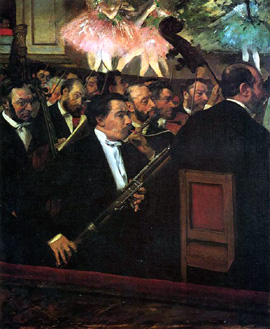
The orchestra at the
Opera House
c. 1868-69
Musée d'Orsay, Paris
|
Fond of "modernity" and admirer
of urban life, Degas is an skeptic observer without illusions, who
often seeks to express in his paintings inconsistency, bitterness,
unusual or incomprehensible of situations.
During the franco-prussian war of 1870, Degas will serve, like
Manet, in the National Guard in Paris. After the Commune, he will visit
some of his relatives in the New-Orleans, from which he will bring back
the famous painting " Portraits in a New Orleans Cotton
office " - 1873
Degas is co-organizer of the 1st group exhibition of the
Impressionists in 1874, and will from there on only exhibit in the
shows of the Impressionist group.
 PAINTER OF MOVEMENT PAINTER OF MOVEMENT
| |
As Degas did not have to sell his paintings
to live, he will continue to work, without order, on his favorite
subjects: contemporary portraits, horse-races, café scenes, scene
world. He will get more and more interested in ballet,
which will become to him the artistic dominating matter.
He sees in the ballet, apart from the magic
which it exerts on him, an ideal subject of observation of fast motion,
as well as a vast opportunity for space composition, offered by all the
surface of the scene.
Quickly, Degas will get aware, throughout
his backstage observations of artists while at work - exercises,
rehersals -, of the existing shift between the fairyhood of costumes
and spectacles and the miserable social condition of dancers.
For Degas, theatre, music and dance, a
microcosm which focuses the attention of the rich ones who can pay for
luxury of the spectacles, will become a privileged place for
observation of human relationships and contradictory relations between
art, work and business.
|
|
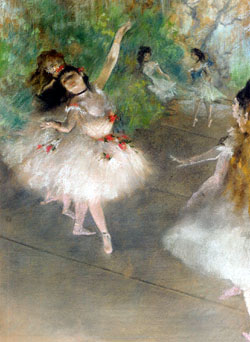
Dancers
1878
Private Collection
|
 ADAPTATION TO HIS EYES'
DESEASE ADAPTATION TO HIS EYES'
DESEASE
Degas had to suffer the effects of some bad deals
of his family, although he will never experience hardship, but above
all he will be affected from 1870 by eyes' disease, which will
continually worsen, in spite of cares, until total blindness in 1911
which will mark the end of his artistic activity.
having a difficult and recluse character, Degas
will live more and more in a certain misanthropy, but his artistic
activity will remain exceptional : to his painting work which he will
make evolve to indoor scenes and to pastel, he will add a work as a
sculptor (and even a short and intense work as a photographer between
1895 and 1896).
|
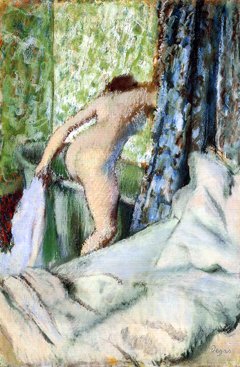
Morning bath
1883
Pastel on paper
Art
Institute of Chicago
|
|
As from 1879, through works such as "Woman
at her dressing table", Degas will get almost exclusively
interested in an extremely ancient theme, that of women at
their toilet.
Ironic, sometimes cruel, but always
objective and bright in the representation, his realism reached with
crudeness often demystifying of women.
Since he had been practising
pastel work for a long time, he will more and more
privilegiate this technique when his sight will get too deteriorated
for meticulous oil painting.
He will take advantage of it to adopt a
freeer and lighter technique, modelling volumes by only mean
of light and enhancing the whole by some strokes of pure
color.
|
As for
Manet, Degas, the painter of ballet dancers, but also
of milliners, horse races and cafés, will arouse admiration
from his contemporains and great respect from young artists of
his time.
Degas
is a too independent personality to be merged completely in the
Impressionist movement. If he is historically one of its main pieces,
what binds him to the Impressionist movement is much more his rebel and
non-conformist mind, his liking for modernity and his desire for a
contemporary painting, rather than his artistic ideas which are often
in opposition with those of the Impressionists.
Degas ceased any artistic activity only since
1911, when he became totally blind.
|
His whole work as a painter, a very
important one (2000 paintings), may be characterized by his truely objective
approach of subjects, an extreme concern about realism,
a precise drawing, and research and study about motion.
He tries to seize motion, in the same
manner as incipient photography - that he practised with success -,
through natural and spontaneous poses.
|
|
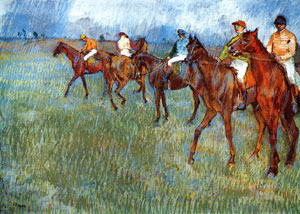
Horsemen, rainy weather
1886
Glasgow
Museums and
Art Gallery , Ecosse
|
|

